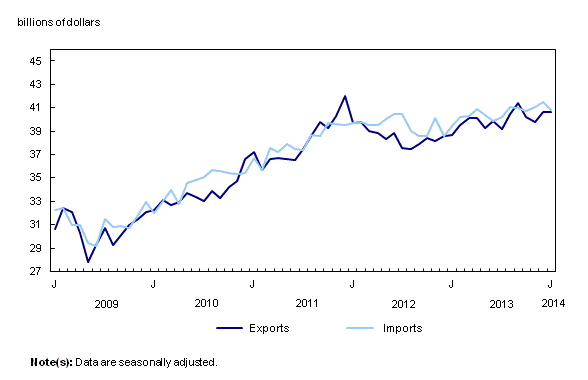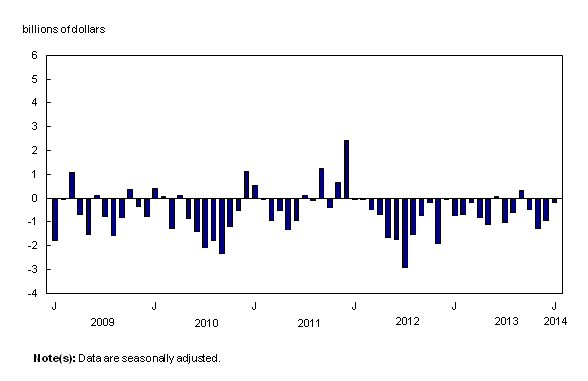Canadian international merchandise trade, January 2014
Archived Content
Information identified as archived is provided for reference, research or recordkeeping purposes. It is not subject to the Government of Canada Web Standards and has not been altered or updated since it was archived. Please "contact us" to request a format other than those available.
Released: 2014-03-07
Canada's merchandise imports declined 1.6% while exports edged up 0.2% in January. As a result, Canada's trade deficit with the world narrowed from $922 million in December to $177 million in January.
Imports declined to $40.8 billion as volumes were down 2.6% while prices were up 1.0%. The main contributors to the overall decline in imports were motor vehicles and parts as well as energy products.
Exports edged up to $40.6 billion, as an increase in energy products was mostly offset by decreases in motor vehicles and parts as well as metal ores and non-metallic minerals. Overall, prices were up 5.8% while volumes were down 5.3%.
Imports from the United States declined 1.8% to $27.1 billion, as imports of motor vehicles and parts as well as aircraft and other transportation equipment and parts fell. Exports to the United States edged down 0.1% to $30.7 billion. Consequently, Canada's trade surplus with the United States widened from $3.2 billion in December to $3.6 billion in January.
Exports to countries other than the United States grew 1.3% to $10.0 billion, as increases in exports to the principal trading area "all other countries" (+9.3%) were partially offset by declines to Japan (-20.1%). Imports from countries other than the United States declined 1.2% to $13.8 billion. Lower imports of crude oil and crude bitumen from Norway led to an 8.6% decrease in imports from the principal trading area "other Organisation for Economic Co-operation and Development countries". This decline was partially offset by a 5.4% increase in imports from the European Union. As a result, Canada's trade deficit with countries other than the United States narrowed from $4.1 billion in December to $3.8 billion in January.
Imports decline on lower volumes
Imports of motor vehicles and parts declined 5.9% to $6.7 billion in January, as motor vehicle engines and motor vehicle parts decreased 7.5%. Passenger cars and light trucks also contributed to the decline, down 5.4% to $2.9 billion, as holiday shutdowns were extended at some manufacturing plants in the United States.
Imports of energy products fell 7.3% to $3.5 billion; the commodity grouping crude oil and crude bitumen (-16.5%) was the main contributor to the section's decline. Overall, volumes were down 6.2%.
Imports of metal ores and non-metallic minerals decreased 16.8% to $891 million. The main factor behind this decline was other metal ores and concentrates (-16.0%), mainly lead and zinc ores and concentrates. Copper ores and concentrates also fell (-70.9%). The declines in January for both of these commodity groupings followed significant increases in December.
Imports of aircraft and other transportation equipment and parts declined 10.3% to $1.2 billion. Imports of aircraft were down $113 million to $170 million.
Imports of electronic and electrical equipment and parts grew 2.6% to $4.8 billion, as volumes and prices rose. The gains in imports were led by communications and audio and video equipment (+5.1%) as well as electronic and electrical parts (+8.5%).
Imports of metal and non-metallic mineral products increased 3.8% to $3.5 billion, a third consecutive monthly gain. Unwrought iron, steel and ferro-alloys, and basic and semi-finished ferrous metal products as well as unwrought copper and copper alloys contributed to the section's increase.
Energy products lead gain in exports
Exports of energy products increased 9.2% to $10.4 billion in January, on the strength of prices. Exports of crude oil and crude bitumen, up 11.6% to $7.4 billion, led the section's increase. Natural gas exports (+12.3%) also contributed to the gain.
Exports of farm, fishing and intermediate food products grew 7.4% to $2.5 billion, the second highest value on record. A 21.5% gain in exports of wheat led widespread increases in the section. Both prices and volumes contributed to the section's gain.
Exports of consumer goods rose 3.8% to $4.6 billion. The main contributors to the increase were pharmaceutical and medicinal products (+11.5%), miscellaneous goods and supplies (+8.9%), and other food products (+4.5%), mainly yellow peas and red lentils.
Exports of metal ores and non-metallic minerals declined 11.7% to $1.4 billion. The main factor behind the decrease was copper ores and concentrates, down $215 million to $130 million in January on lower volumes (-63.3%).
Exports of motor vehicles and parts fell 11.0% to $5.2 billion, as volumes were down 12.5%. An extension of holiday shutdowns in both the United States and Canada contributed to the decrease in exports of both motor vehicle engines and motor vehicle parts (-21.8%) and passenger cars and light trucks (-8.1%).
Note to readers
Merchandise trade is one component of Canada's international balance of payments (BOP), which also includes trade in services, investment income, current transfers as well as capital and financial flows.
International merchandise trade data by country are available on both a BOP and a customs basis for the United States, Japan and the United Kingdom. Trade data for all other individual countries are available on a customs basis only. BOP data are derived from customs data by making adjustments for factors such as valuation, coverage, timing and residency. These adjustments are made to conform to the concepts and definitions of the Canadian System of National Accounts.
Data in this release are on a BOP basis, seasonally adjusted and in current dollars. Constant dollars are calculated using the Laspeyres volume formula (2007=100).
For more information on seasonal adjustment, see "Seasonal adjustment and identifying economic trends."
Revisions
In general, merchandise trade data are revised on an ongoing basis for each month of the current year. Current year revisions are reflected in both the customs and BOP based data.
The previous year's customs data are revised with the release of the January and February reference months as well as on a quarterly basis. The previous two years of customs based data are revised annually and are released in February with the December reference month.
The previous year's BOP based data are revised with the release of the January, February and March reference months. To remain consistent with the Canadian System of macroeconomic accounts, annual revisions will take place in December with the October reference month rather than in June, as was previously the case.
Factors influencing revisions include late receipt of import and export documentation, incorrect information on customs forms, replacement of estimates produced for the energy section with actual figures, changes in classification of merchandise based on more current information, and changes to seasonal adjustment factors.
Revised data are available in the appropriate CANSIM tables.
These data are now available in the Canadian International Merchandise Trade Database (Catalogue number65F0013X). From the Browse by key resource module of our website, choose Publications.
The January 2014 issue of Canadian International Merchandise Trade, Vol. 68, no. 1 (Catalogue number65-001-X), is also now available from the Browse by key resource module of our website under Publications.
Data on Canadian international merchandise trade for February will be released on April 3.
Contact information
For more information, contact us (toll-free 1-800-263-1136; 514-283-8300; infostats@statcan.gc.ca).
To enquire about the concepts, methods or data quality of this release, contact Alec Forbes (613-951-0325), International Trade Division.
- Date modified:



